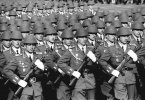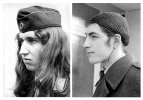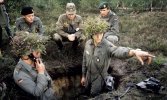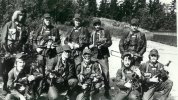No Nokia sai lännestä luvan myydä puhelinkeskuksia Neuvostoliittoon, vaikka ne sisälsivät läntistä teknologiaa. On epäilty, että vastineeksi vientiluvasta, niinhin sisällytettiin pieniä trojalaisia...Suomi oli Neuvostoliiton koekenttä lännessä.
Install the app
How to install the app on iOS
Follow along with the video below to see how to install our site as a web app on your home screen.
Note: This feature may not be available in some browsers.
You are using an out of date browser. It may not display this or other websites correctly.
You should upgrade or use an alternative browser.
You should upgrade or use an alternative browser.
Kylmän sodan salaisuudet??
- Viestiketjun aloittaja Hejsan
- Aloitus PVM
Olympiakasarmi
Kenraali
Kylmän sodan panssarintorjunta-ase, neutronipommi. Vasemmisto leimasi sen kapitalistien aseeksi joka tappaa ihmiset, mutta jättää rakennukset ehjiksi.
 fi.wikipedia.org
fi.wikipedia.org
Neutronipommi – Wikipedia
tulikomento
Supreme Leader
Tiede ja Ase -julkaisun vuoden 1970 numerossa artikkeli siviilivastarinnan järjestämisestä miehitystilanteessa. Selvästi mukana Tsekkoslovakian 1968 kokemukset. Kuulemma tämä on artikkelin sensuroitu versio. Sensuroimattomassa versiossa mainittiin jopa Neuvostoliitto nimeltä potentiaalisena vihollisena.
Tiede ja ase Vol 28 (1970)
Sotatieteellisen seuran vuosijulkaisu; Annual publication of the Finnish Society of Military Science
journal.fi
tulikomento
Supreme Leader
DDR:n kansanarmeijan lakkauttamisseremonia sekä tätä seuranneena päivänä saman joukko-osaston muuttuminen Bundeswehrin yksiköksi.
etappisika
Luutnantti
Mitenköhän integroituminen lopulta sujui? Lasse Lehtisen muistelmissa oli juttua, miten tämä oli käynyt kansanedustaja-aikoinaan tutustumassa eri maiden armeijoihin. Ainakin Ruotsin, Neuvostoliiton ja DDR:n armeijat tuli tsekattua. DDR-armeijasta muisteli, että meininki näytti todella pahalta ja ikävältä, suoraan sanoen natsimeiningiltä.DDR:n kansanarmeijan lakkauttamisseremonia sekä tätä seuranneena päivänä saman joukko-osaston muuttuminen Bundeswehrin yksiköksi.
tulikomento
Supreme Leader
Mitenköhän integroituminen lopulta sujui? Lasse Lehtisen muistelmissa oli juttua, miten tämä oli käynyt kansanedustaja-aikoinaan tutustumassa eri maiden armeijoihin. Ainakin Ruotsin, Neuvostoliiton ja DDR:n armeijat tuli tsekattua. DDR-armeijasta muisteli, että meininki näytti todella pahalta ja ikävältä, suoraan sanoen natsimeiningiltä.
Suurin osa NVA:n kantahenkilökunnasta, 36 000 upseeria ja kanta-aliupseeria jäi työttömäksi. Muistelen että everstiluutnanttia korkeampia derkku-upseereita ei otettu Bundeswehriin. Ne jokunen tuhat jotka otettiin, aloittivat yhtä pykälää alemmalla upseeriarvolla.
Tässä lisää aiheesta auf deutsch.
NVA oli sekoitus preussilaista militarismia ja kommunismin ideologiaa. Varusmiespalvelus NVA:ssa ei tosiaan ollut mitään leikkiä lepokodissa.
Hyvin pitkä artikkeli

 spectrum.ieee.org
spectrum.ieee.org
On February 11, 1955, an anonymous tip led two New York Police Department detectives and two New York Telephone Company investigators to an apartment on the fourth floor of a residential building at 360 East 55th Street in midtown Manhattan. In the back bedroom of the unit, the group discovered a cache of stolen wiretapping equipment that turned out to have direct lines into six of New York City’s largest telephone exchanges: PLaza 1, 3, and 5; MUrray Hill 8; ELdorado 5; and TEmpleton 8. The connections blanketed an area of Manhattan running from East 38th Street to East 96th Street, a swath of the city’s most expensive real estate.
“There wasn’t a single tap-free telephone on the east side of New York,” professional wiretapper Bernard Spindel remarked of the arrangement. (Spindel was in all likelihood the source of the anonymous tip.) News of the discovery made the front page of the New York Times a week later.
The midtown Manhattan “wiretap nest,” as the 55th Street listening post came to be known, remains one of the largest and most elaborate private eavesdropping operations ever uncovered in the United States. Subscribers whose phones were tapped at the time of the raid included a range of New York commercial interests, with assets both large and small: a modeling agency and an insurance company; an art gallery and a lead mining company; and perhaps most sensationally, two publicly traded pharmaceutical corporations with competing patent interests. (The two firms, Bristol-Myers and E. R. Squibb, were at the time locked in a nasty legal battle over the commercial rights to the antibiotic tetracycline. Evidence later revealed that representatives from a third firm, Pfizer, had employed the wiretap nest to spy on both entities, paying more than $60,000 in cash for the service.)

When New York City Was a Wiretapper’s Dream
Eavesdropping flourished after WW II, aided by legal loopholes, clever hacks, and “private ears”
 spectrum.ieee.org
spectrum.ieee.org
tulikomento
Supreme Leader
Jenkkilaivaston filmi neuvostolaivastosta 70-luvun puolivälistä. Noihin aikoihin amiraali Sergei Gorskov rakensi valtamerilaivastoaan.
tulikomento
Supreme Leader
Heikki Tiilikainen muistelee syksyä 1968. Toimi tuolloin rannikkotykistön upseerina.

 www.is.fi
www.is.fi

Venäläisiä sota-aluksia lipui pahaenteisesti kohti Kotkaa vuonna 1968
Kotkan edustan linnakkeessa vietettiin jännittäviä hetkiä Tshekkoslovakian miehityksen aikaan.
tulikomento
Supreme Leader
tulikomento
Supreme Leader
Tanskalainen historiantutkija on löytänyt Puolan arkistoista Tanskaa koskevan neukkujen sotasuunnitelman vuodelta 1989. 131 ydinaseiden kohdetta oli maalitettu.

 nyheder.tv2.dk
nyheder.tv2.dk
1989-plan for atomangreb mod Danmark ser dagens lys
En historiker, der har fundet en atomangrebsplan mod Danmark, kalder denne for en "sovjetisk plan".
tulikomento
Supreme Leader
Yksi kuuluisimmista kylmän sodan rajaloukkauksista, eli kevään 1978 tapaus Wickenberg.
tulikomento
Supreme Leader
Juttua KGB:n "varpusista".

 thehiddenhistory.substack.com
thehiddenhistory.substack.com

The Mysterious Cold War School for Sex Spies
At the height of the cold war, the Soviet Union created a specialist training school for women agents called ‘sparrows’ who were trained to seduce their targets with sexpionage.
Satun työkuvioiden kautta tuntemaan yhden saksalaisen, joka palveli aliupseerina 80-luvun lopulla NVA:ssa juuri ennen DDR:n hajoamista. Kun tausta paljastui, niin tietysti utelin kaikenlaista asiaan liittyvää. Hän oli sitä mieltä, että NVA oli osaamistasoltaan paras Varsovan liiton armeijoista, siis neuvostoarmeijaakin parempi. Kylmän sodan lopulla oli kuitenkin ongelmana kaluston vanhentuminen ja erityisesti puutteellinen pimeätoimintakyky. Bundeswehria kommentoi, että se oli sellainen maanantaista perjantaihin -armeija, joka lähti viikonlopuksi kotiin ryyppäämään.NVA oli sekoitus preussilaista militarismia ja kommunismin ideologiaa. Varusmiespalvelus NVA:ssa ei tosiaan ollut mitään leikkiä lepokodissa.
tulikomento
Supreme Leader
Satun työkuvioiden kautta tuntemaan yhden saksalaisen, joka palveli aliupseerina 80-luvun lopulla NVA:ssa juuri ennen DDR:n hajoamista. Kun tausta paljastui, niin tietysti utelin kaikenlaista asiaan liittyvää. Hän oli sitä mieltä, että NVA oli osaamistasoltaan paras Varsovan liiton armeijoista, siis neuvostoarmeijaakin parempi. Kylmän sodan lopulla oli kuitenkin ongelmana kaluston vanhentuminen ja erityisesti puutteellinen pimeätoimintakyky. Bundeswehria kommentoi, että se oli sellainen maanantaista perjantaihin -armeija, joka lähti viikonlopuksi kotiin ryyppäämään.
Uskon hyvin. NVA piti itseään "ainoana oikeana saksalaisena armeijana." Eli se omi itselleen kaikki vanhat preussilaisperinteet. Koulutus ja kuri oli kovaa ja olen valmis allekirjoittamaan tuon että hyvin todennäköisesti Itä-Saksan kansanarmeija oli Varsovan liiton armeijoista tehokkain heti neuvostoarmeijan jälkeen. Bundeswehrille oli ominaista tietynlainen "low key professionalism", eli sotilaallista ulkonäköä ja habitusta välteltiin ja koulutuskin saattoi näyttää ulkoapäin välillä vätystelyltä, mutta uskon kyllä että kylmän sodan vuosina BW oli kyllä hyvin koulutettu ja sen kantahenkilökunta ja reserviläiset olivat sitoutuneet kotimaansa puolustamiseen. Myös aseistus ja varustus oli varsinkin kylmän sodan loppupuolella kovaa tasoa.
DDR

Bundeswehrin hiusverkot 70-luvulla

Tornisteri
Luutnantti
Naton armeijoissa noita hiusverkkoja samoihin aikoihin tarjottiin mm. Hollannissa joista olen nähnyt samanlaisia kuvia.
Tuohon aikaan miesten muoti suosi pitempää tukkaa ja kun miettii noihin aikoihin tiettyjä valokuvia meidänkin varusmiespalveluksestamme niin monella oli ylitse korvien menevää mallia meilläkin vaikkei nyt sentään ihan tuollaisia sallittukaan.
Vähän lähempää esimerkkinä tosiaan länsinaapurimme, jossa nuo hiusverkot olivat kanssa jakotavaraa varusmiehille vallattomia pehkoja ja piiskatukkia kaitsemaan. Viiksiä ja partaakin sai ilmeisesti olla.
Tuohon aikaan miesten muoti suosi pitempää tukkaa ja kun miettii noihin aikoihin tiettyjä valokuvia meidänkin varusmiespalveluksestamme niin monella oli ylitse korvien menevää mallia meilläkin vaikkei nyt sentään ihan tuollaisia sallittukaan.
Vähän lähempää esimerkkinä tosiaan länsinaapurimme, jossa nuo hiusverkot olivat kanssa jakotavaraa varusmiehille vallattomia pehkoja ja piiskatukkia kaitsemaan. Viiksiä ja partaakin sai ilmeisesti olla.
Liitteet
Mulla oli -85/86 tupakaverinani 19-vuotias "ruotsalainen", joka oli perheineen muuttanut 1-vuotiaana Suomesta Ruotsiin. Oli pitänyt tuolloin kansalaisuuden, vaikka suomi ei ollut kunnolla hallussa. ja kun palvelusikä tuli, oli päätös kuulemma ihan selvä. "Mää en mihinkään hiusverkkojoukkoon mene, mää menen Suomeen palvelukseen."Naton armeijoissa noita hiusverkkoja samoihin aikoihin tarjottiin mm. Hollannissa joista olen nähnyt samanlaisia kuvia.
Tuohon aikaan miesten muoti suosi pitempää tukkaa ja kun miettii noihin aikoihin tiettyjä valokuvia meidänkin varusmiespalveluksestamme niin monella oli ylitse korvien menevää mallia meilläkin vaikkei nyt sentään ihan tuollaisia sallittukaan.
Vähän lähempää esimerkkinä tosiaan länsinaapurimme, jossa nuo hiusverkot olivat kanssa jakotavaraa varusmiehille vallattomia pehkoja ja piiskatukkia kaitsemaan. Viiksiä ja partaakin sai ilmeisesti olla.
Viimeksi muokattu:
tulikomento
Supreme Leader
Naton armeijoissa noita hiusverkkoja samoihin aikoihin tarjottiin mm. Hollannissa joista olen nähnyt samanlaisia kuvia.
Tuohon aikaan miesten muoti suosi pitempää tukkaa ja kun miettii noihin aikoihin tiettyjä valokuvia meidänkin varusmiespalveluksestamme niin monella oli ylitse korvien menevää mallia meilläkin vaikkei nyt sentään ihan tuollaisia sallittukaan.
Vähän lähempää esimerkkinä tosiaan länsinaapurimme, jossa nuo hiusverkot olivat kanssa jakotavaraa varusmiehille vallattomia pehkoja ja piiskatukkia kaitsemaan. Viiksiä ja partaakin sai ilmeisesti olla.
Yhdeltä jenkkitutulta kuulin tällaisen jutun että kun jossain 80-luvulla pidetyssä Naton sotaharjoituksessa harjoiteltiin jonkun länsisaksalaisen joen ylitystä, seisoi koko monikansallinen joukko tuntikausia joen väärällä puolella. Syynä oli se, että hollantilaiset varusmiespioneerit olivat enemmän kiinnostuneet ostamaan jenkeiltä ruohoa kuin rakentamaan tarvittavaa siltaa joen yli.


